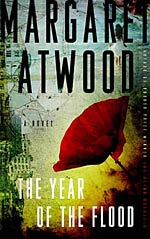
![]() Nymeria
Nymeria
11/22/2015
![]()
As I started this second book in Atwood's MaddAddam trilogy and realized it covered the same ground of its predecessor, Oryx and Crake, albeit from a different perspective, I was afraid it would turn out boring or predictable - or both. Well, I could not have been more wrong.
Even though we are brought to re-live the events leading up to the man-made plague that wipes out most of humanity through the eyes of two survivors and through the use of flash-back as in the previous novel, these two characters are far more interesting, relatable and real than Jimmy the Snowman ever was. Ren is a sex worker in a place called Scales and Tails who, when the plague hits, finds herself in an isolation room as a precautionary measure against a bite received by a client; Toby found refuge from hardship with the God's Gardeners, a sect preaching the return to a simpler life-style as a means to better humanity, and she survives by holing up the high-end spa where she was hiding. The God's Gardeners group, to which both belonged for a time, can be considered another point-of-view of the novel, their preaching focused on the unavoidable advent of the Waterless Flood - from which the book takes its title - a scourge that, in their credo, will wash over humanity with dramatic consequences and for which the sect tries to prepare in an attempt to insure the survival of the species.
Familiar characters from Oryx and Crake make their appearance as well, with particular focus on Glenn/Crake and Jimmy/Snowman: if their somewhat damaged personalities did nothing to endear them to me before, looking at them through other eyes and from a different perspective made me see them in an even worse light, as creatures totally incapable of love and empathy, gliding through life enclosed in the sterile bubble of their own self-centeredness. If Jimmy is "only" guilty of making light fun of everything and everyone, taking and discarding with no thought for others' feelings, never establishing a firm tie with another human being (and for that his extreme loneliness after the apocalypse seems a just punishment), Glenn appears even more like a cold schemer, using others - including the naïve Gardeners - to further his plan of ridding the world of the "useless" emotions he's unable to process or enjoy.
As a counterpoint, Toby and Ren stand out in sharp relief: they have suffered from life's injuries in a major way and known despair and degradation, yet they both are able to reach out past these barriers of pain to touch others and to create bonds of friendship that bring a little light of hope in this bleak scenario of destruction. Toby was left alone and destitute by a chain of events triggered by the big corporations' greed, and she steps on the lowest rung of her personal descent into Hell working for Secret Burgers, a fast food chain where it's better not to inquire too deeply into the nature of the meat: here she becomes the target of the brutish Blanco, a manager who sexually abuses his employees (and who transforms into a sort of nemesis throughout most of the story) and is saved by the Gardeners who take her into their fold. Here, through the examples of Rebecca, who shows her how to stand up for herself, and those of Pilar, who teaches her herb lore and to care for bees, she finds her place in Gardeners' society and the strength to survive the Flood and face her own demons. Ren comes to the Gardeners with her mother, a distant, selfish woman attaching herself to the sect for lust-induced attraction to a man: life with the Gardeners agrees with Ren much more than that of the privileged enclaves she comes from, and where her mother takes them back after a while, while her friendship with strong and resourceful Amanda defines her character and shapes her future actions. On hindsight, The Year of the Flood is a very female-oriented tale: these women's courage and the loyalty they show each other, their endurance and capacity to withstand the worst and reinvent themselves is indeed the only glimmer of light in the darkness of the world's end.
The book closes at the same point its predecessor did, a full circle that nonetheless delivers more information: there are other survivors, attempting to find a way to deal with this dramatically altered world, one where climate changes and genetically engineered animals are a constant threat to life. Who will inherit this world, the remnants of the human race or the test-tube humans created by Crake? Hopefully the answer lies in the last volume of this trilogy: whatever path the author choose to lead her readers to that answer, I believe it will be a fascinating journey.
http://spaceandsorcery.wordpress.com